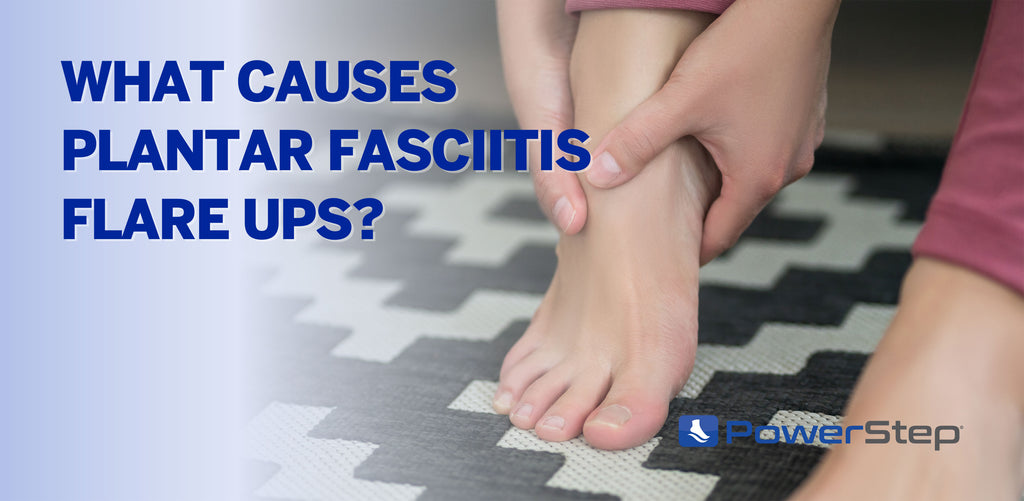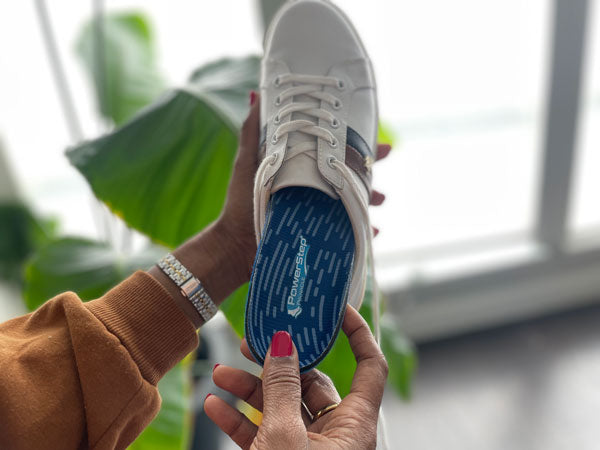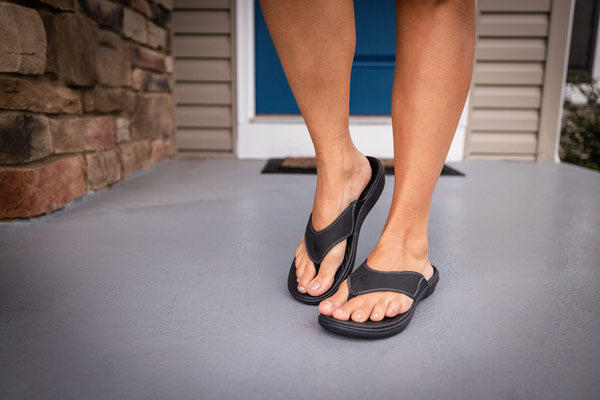Plantar Fasciitis Flare Up: Causes & Treatments

What causes plantar fasciitis to flare up?
If you struggle with recurring foot and heel pain, you could be experiencing a plantar fasciitis flare up. Plantar fasciitis is the most common cause of heel and foot pain. It happens when the plantar fascia, the tissue running along the bottom of your foot, gets inflamed from too much strain.
By addressing the cause of your foot pain and using our clinically proven PowerStep® insoles for plantar fasciitis, you can relieve pain and keep plantar fasciitis from coming back.

What Makes Plantar Fasciitis Flare Up?
Anything that puts too much stress on your feet can make plantar fasciitis worse. Plantar fasciitis flare up symptoms include sudden pain in your heel or arch that may start out in the morning and worsen throughout the day.
Some of the most common reasons why your plantar fasciitis keeps coming back may include the following:
1. Increase in Physical Activity
Plantar fasciitis flares up because of a sudden increase in physical activity. For example, starting a new fitness routine or working a retail job and standing all day can cause aching foot pain. The sudden strain on your feet exacerbates plantar fasciitis symptoms.
Always ease into more intense activities to avoid common workout injuries like plantar fasciitis. If you’re a new runner training for a race, use our Couch to 5K training plan. Avoid being sedentary in winter by taking your winter walk indoors.

Foot stretches before and after physical activity can help prevent pain as well as wearing shoes with arch support inserts like PowerStep PULSE® performance insoles.
2. Rapid Weight Gain
Sudden weight gain, including healthy weight gain from pregnancy, puts added pressure on your feet and the plantar fascia, causing inflammation and pain. Resting and elevating your feet can help. Talk to your doctor about whether losing weight is an option for you.

If you have plantar fasciitis and overpronate because of your weight, wearing an orthotic like PowerStep Pinnacle® Maxx insoles helps take the pressure off your arches, relieve pain, and prevent problems caused by overpronation.
3. Wearing the Wrong Shoes
Shoes that lack support like flips flops, high heels, or flat tennis shoes can cause heel and arch pain. Your feet need arch support and plenty of cushioning to help absorb the impact of every step and distribute it evenly across your feet.
Old, worn shoes and brand new shoes that feel uncomfortable can also make plantar fasciitis flare up. Wearing the right shoes for plantar fasciitis is critical to preventing the condition from recurring.

Only buy shoes that are comfortable for your feet and in the right size. For arch support, replace your insoles with plantar fasciitis inserts like PowerStep Pinnacle insoles that can be moved from shoe to shoe for support in every pair.
4. Skipping Your Exercises
Your plantar fasciitis might return if you stop doing your plantar fasciitis stretches. One of the best treatments for plantar fasciitis includes exercises like calf stretches and toe curls that strengthen the plantar fascia to prevent tearing.
Make it a priority to stretch your feet and calves before or after you work out, at bedtime, and in the morning. The PowerStep UltraFlexx® Foot Rocker makes stretching your feet and lower legs easier by providing a deep stretch that relieves pain. The device is perfect for those with mobility problems or who struggle to reach their toes.
5. Other Risk Factors
Some individuals are more prone to plantar fasciitis flare ups for several reasons. Risk factors that may increase your chance of recurring foot pain are:
- Having flat feet or high arches
- Being overweight
- Foot ailments like bunions
- Arthritis or gout
- Careers or hobbies that require lots of standing
- Being a long distance runner
- Injuries to the Achilles tendon or calf muscles
How long does a plantar fasciitis flare up last?
If you've dealt with aching foot pain from plantar fasciitis before, then having the condition come back can feel overwhelming. Thankfully, simple treatments like resting, stretching, and wearing plantar fasciitis insoles help 90% of patients recover within 10 months.
With PowerStep insoles, you can get relief from your plantar fasciitis flare up sooner and keep the condition from reoccurring. According to our clinical research, 90% of PowerStep users have less foot, knee, and back pain within two weeks.
Treatment Options
Making small changes to your daily life can significantly improve your pain and prevent plantar fasciitis from flaring up again. Regular treatments that you can do at home include:
- Wearing insoles: PowerStep orthotic insoles for plantar fasciitis are clinically proven to relieve and prevent pain from plantar fasciitis.
- Stretching: Keep your plantar fascia strong and flexible by doing lower leg and foot stretches for at least 20 minutes a day.
- Massaging: Use a massage ball, golf ball, or frozen water bottle to massage your heel and arch, reduce stiffness and help with pain.
- Resting and icing: Stay off your feet when they hurt and apply ice using the PowerStep Hot/Cold Therapy Wrap to reduce inflammation.
- Using a pain reliever: NSAIDs like ibuprofen help relieve pain, but a natural pain reliever like Doctor Hoy’s topicals provide fast relief that’s safe, clean, and effective.
- Wearing a night splint: Night splints speed up recovery and prevent plantar fasciitis pain first thing in the morning. The PowerStep UltraStretch® Night Sock is a comfortable, easy to wear alternative.

If your foot pain does not go away despite these changes, see a podiatrist about a plantar fasciitis flare up treatment plan. They can determine how severe the condition is and recommend options like physical therapy or corticosteroid injections. Rarely does plantar fasciitis require surgery.
Does plantar fasciitis ever go away?
Plantar fasciitis can go away on its own if you rest your feet, stretch them regularly, and take measures against flare ups like wearing the right shoes with arch support and orthotic insoles.
PowerStep: The Best Insoles for Plantar Fasciitis
Designed by a podiatrist, PowerStep orthotics are the best insoles for plantar fasciitis. Our signature arch support, premium cushioning, and deep heel cup provide the right balance of comfort and support so you can finally stop your plantar fasciitis from coming back.
References:
Burch, K. (2023, February 10) What Causes Plantar Fasciitis to Flare Up? Verywell Health.
Gindi, E. DPM. (n.d.) How to Prevent Plantar Fasciitis From Returning. Valley Stream Podiatrist.



















